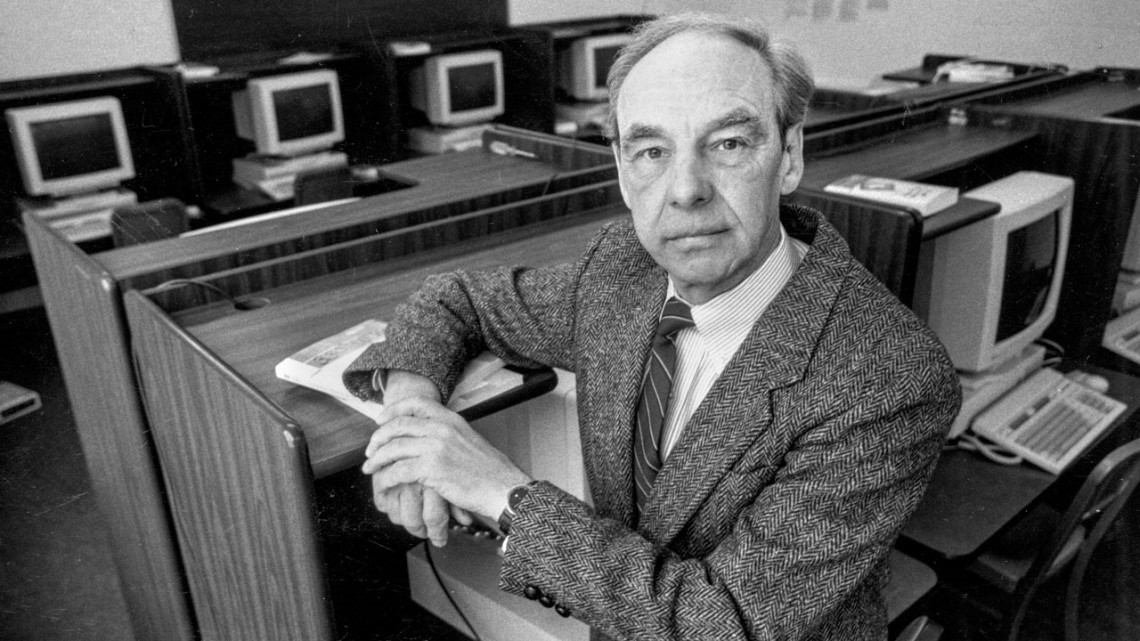 |
| Juris Hartmanis 1928-2022 |
On Friday, July 29th, I was in the immigration line at an airport in Mexico. My phone rang with Bill Gasarch on the Caller ID but starting vacation I declined the call. The voicemail gave me the sad news that Juris Hartmanis, the person who founded computational complexity and brought me into it passed away earlier that day. I messaged Bill and told him to write an obit and I'd follow with something personal when I returned.
 |
| Hartmanis and Stearns in 1963 |
In November 1962 Hartmanis, working with Richard Stearns at the GE Labs in Schenectady, determined how to use Turing machines to formalize the basic idea to measure resources, like time and memory, as a function of the problem being solved. Their classic Turing-award winning paper On the Computational Complexity of Algorithms, not only gave this formulation but showed that increasing resources increased the problems one can solve. The photo above, from a post celebrating the 50th anniversary of the paper, shows Hartmanis and Stearns with the main theorem of their paper on the board.
Twenty-one years later, a junior at Cornell University still trying to find his way took undergraduate theory from the man himself. Juris brought the topics to life and I found my passion. At the beginning of the class, he said the highest grade usually went to an undergrad followed by the grad students in the class. I was a counterexample, as I had the second highest grade. Never did find out who beat me out.
In spring of my senior year, 1985, I forgave the traditional senior-slump Wines for graduate complexity with Juris. He focused the course around the isomorphism conjecture he developed with his student Len Berman, which implied P≠NP, and Hartmanis believed using the conjecture might lead to settling P v NP. He offered an automatic A to anyone who could prove the isomorphism conjecture. I guess any other proof of P≠NP only warranted a B?
I would later be obsessed by the isomorphism conjecture as an assistant professor, coming up with not one but two oracles making it true. The isomorphism conjecture didn't end up settling P vs NP, but then again neither did any other approach.
It wasn't just me, there was a reason that many of the great American complexity theorists, including Ryan Williams, Scott Aaronson and my own PhD advisor Michael Sipser, were undergrads at Cornell. Many more were PhD students of Hartmanis.
Juris Hartmanis had a certain gravitas in the community. Maybe it was his age, the way he dressed up, his seminal research in the field, or just that Latvian accent. He founded the CS department at Cornell in the 60s and served as head of the CISE directorate at the National Science Foundation in the 90s. His 60th birthday party at the 3rd Structures in Complexity conference (now the Computational Complexity Conference) was the only time I've seen complexity theorists in ties.
 |
| Juris Hartmanis (center) being toasted by Janos Simon |
A few of my favorite Hartmanis quotes.
- "We all know P is different than NP. We just don't know how to prove it." - Still true.
- "I only make mistakes in the last five minutes of the class." - Sometimes he made a mistake with ten minutes left but only admit it in the last five minutes.
- "Primality is a problem not yet know to be in P but is hanging on by its fingernails with its grip continuing to loosen each day." - Juris Hartmanis said this in 1986, with primality hanging on for another 16 years.
Thanks Juris for creating the foundations of our field and inspiring so many people, yours truly included, to dedicate ourselves to it.
Much more to read:
- In 1981 Hartmanis wrote a personal article for the Annals of History of Computing describing the birth of computational complexity and his role in it.
- A CACM interview with Hartmanis gives a personal story of his path from Latvia to Kansas City to Pasadena to Schenectady to Ithaca and DC.
- Obits by Cornell, Ryan Williams and Dick Lipton and Ken Regan.
- My old blog posts celebrating Hartmanis' 90th birthday and the 50th anniversary of Hartmanis-Stearns,
- And the many retrospectives, remembrances, special issues and conferences to come.
May he rest in peace. He passed away on July 29th, not Aug 29th. Thank you.
ReplyDeleteThanks. Fixed the date.
DeleteI was sad to read about Hartmanis passing away - there was much to admire about him; not only was he a legend in the field, but he was super inspiring to graduate students that he did not advise. In the 80s he was a central (founding) figure in Cornell CS and continued to inspire those of us who took a class with him, and were working in TCS, if not complexity theory. Very approachable, humble and friendly. The one time he was talking about isomorphism conjecture, I was totally confused, as I was thinking "graph isomorphism"! I am pretty sure he thought GI would be in P (eventually) as well. He made research fun, and interesting, but more importantly he was a role model for many of us. I recall a story about how he worked hard to recruit John Hopcroft from Princeton and I recall that he even went to NJ to convince Hopcroft to join Cornell CS, of course Hopcroft can confirm this.
ReplyDelete